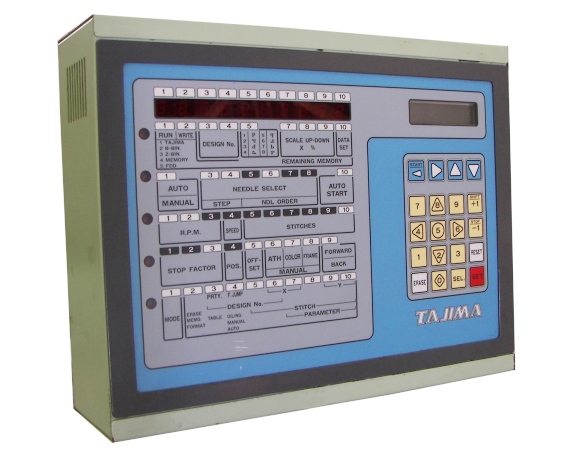Tajima TME-DC, TMFD-DC User ManualInstructions(C) 2009-2018 PLR Electronics
BasicsThere are four kinds of the Tajima TME-DC machine:
Main buttons (on the right)
Main menu list
LCD buttons (upper right)
Status lights
Bar switch and button (under table, certain models only)
Frame move, ATH, RPM
Load a new designLoading from the Disk Drive or USB Floppy Emulator. Loading from the Tape Reader or USB Reader. 1. Move the cursor to the WRITE position, in Row 1, WRITE 2. 2. Press the 1 key and then press SET. 3. The blinking number is the first empty memory location for your new file. 4. Change this memory location or leave it. 5. You have the option now to name the design. Press SEL KEY here if you want to name it, on the extra LCD screen. Use the upper left-right keys and SET to choose a name, and SEL KEY when done. 6. Press SET to accept memory location and name. 7. The rotation option will blink now. It defaults to 1, which is no rotation. Press SET to accept. 8. The scale option will blink now. It defaults to 100 percent. Press SET to accept. 9. The final choice is auto jump, usually 1 for auto-jump disable. Press 1 and SET to begin the download process. 10. Completion! You don’t have a Tape Reader? Purchase a new USB Reader for your Tajima TME-DC machine, that can also be plugged into your older Tajima machines! Look at the front page of PLR Electronics! Select a design in memory1. Move the cursor to the RUN position, in Row 1, RUN. Setting color change1. Move the cursor to the AUTO/MANUAL position, in Row 2, AUTO/MANUAL. Erasing design in memory1. Move the cursor to the RUN position, in Row 1, RUN. Erasing all designs1. Move the cursor to the RUN position, in Row 1, RUN. Manual color change1. Move the cursor to the COLOR position, in Row 4, COLOR. Immediate thread trimming1. Move the cursor to the ATH position, in Row 4, ATH. Hydraulic table1. Only applicable if you have the hydraulic table. Tajima Error CodesPress the RESET button to cancel most errors. You may have to change menus to the STOP FACTOR menu.
 (C) 2009-2018 PLR Electronics |
Tajima TME-DC

